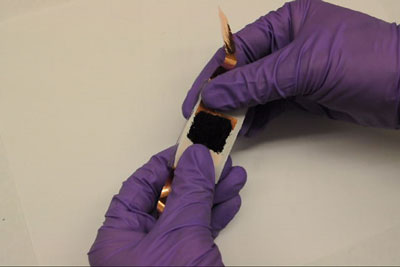| Dec 12, 2012 |
Power sources for flexible, stretchable electronics
|
|
(Nanowerk News) Electronic devices become smaller, lighter, faster and more powerful with each passing year. Currently, however, electronics such as cell phones, tablets, laptops, etc., are rigid. But what if they could be made bendable or stretchy?
|
|
According to the University of Delaware’s Bingqing Wei, stretchable electronics are the future of mobile electronics, leading giants such as IBM, Sony and Nokia to incorporate the technology into their products.
|
 |
| This image shows a fully stretchable supercapacitor composed of carbon nanotube macrofilms, a polyurethane membrane separator and organic electrolytes.
|
|
Beyond traditional electronics, potential stretchable applications include biomedical, wearable, portable and sensory devices, such as cyber skin for robotic devices and implantable electronics.
|
|
“Advances in soft and stretchable substrates and elastomeric materials have given rise to an entirely new field,” says Wei, a mechanical engineering professor at UD.
|
|
But even if scientists can engineer stretchable electronics – what about their energy source?
|
|
“Rechargeable and stretchable energy storage devices, also known as supercapacitors, are urgently needed to complement advances currently being made in flexible electronics,” explains Wei.
|
|
Wei’s research group at the University is making significant progress in developing scalable, stretchable power sources for this type of application using carbon nanotube macrofilms, polyurethane membranes and organic electrolytes.
|
|
This, he says, requires new thinking about materials processing and device manufacturing to maximize energy storage without compromising energy resources.
|
|
To reveal a stretchable supercapacitator’s true performance, the Wei group examined the system’s electrochemical behavior using buckled single-wall nanotube (SWNT) electrodes and an elastomeric separator.
|
|
According to Wei, the supercapacitor developed in his lab achieved excellent stability in testing and the results will provide important guidelines for future design and testing of this leading-edge energy storage device.
|
|
As they work to refine the technology, Wei has filed a provisional patent to protect his team’s research. The work was recently published in Nano Letters ("Dynamic and Galvanic Stability of Stretchable Supercapacitors"), a journal of the American Chemical Society.
|

